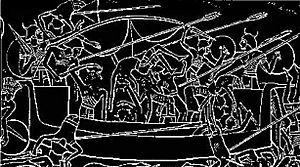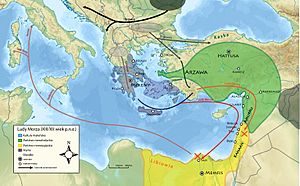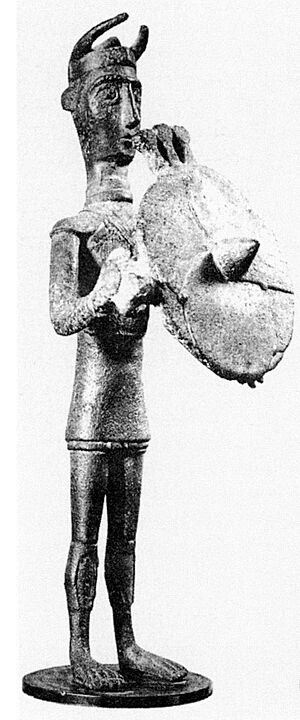Sherden facts for kids
The Sherden were one of the groups known as the Sea Peoples. They appear in old records from ancient Egypt and Ugarit around 1300-1100 BC. These records describe them as a strong and mysterious group from the Eastern Mediterranean.
When shown in ancient art, the Sherden warriors look very distinct. They carried round shields and spears. They also used short daggers or swords. A key feature of their look was a special helmet with horns. Most of these helmets also had a round decoration on top. Sometimes, they wore body armor called corslets and kilts. At a place called Medinet Habu in Egypt, their armor looks similar to what the Philistines wore. Some experts believe their swords might have come from larger European daggers.
Contents
Who Were the Sea Peoples?
The Sherden were a well-known group among the Sea Peoples. These groups were often pirates who attacked coasts and disrupted trade. This happened especially around the 13th century BC.
Sherden and Egyptian Battles
The Sherden are first mentioned by name in a record from Ramesses II, a powerful Egyptian pharaoh. This record says: "The Sherden were rebellious and hard to fight. They came bravely in warships from the sea. No one could stop them." But Ramesses II claimed he defeated them and brought them to Egypt.
It's thought that some Sherden captured by Egypt might have later worked for the pharaoh. They might have helped build ships or shared their knowledge about sea travel. They may have even helped build the special Egyptian warships seen in carvings at Medinet Habu. These carvings show a big sea battle between Egyptians and the Sea Peoples.
Some historians, like Michael Wood, think the Sherden's raids might have helped cause the fall of the Mycenaean civilization. This was a powerful culture in ancient Greece.
Where Did the Sherden Come From?
Historians are not sure where the Sherden originally came from. No ancient records from the Hittites or Greeks mention them. This suggests they might not have come from those areas.
Ideas About Western Origins
Some people think the Sherden came from the western Mediterranean Sea. They see similarities between "Sherden" and "Sardinians" (people from Sardinia). They also compare "Shekelesh" to "Sicilians" and "Teresh" to "Etruscans". These are all places in the western Mediterranean.
However, some archaeologists disagree. They say that evidence shows these groups arrived in these western areas after the time of Ramesses III. This would mean they didn't come from there originally.
Ideas About Eastern Origins
Another idea is that the Sherden came from the east. English archaeologist Margaret Guido suggested in 1963 that they might have come from Ionia. This area is on the central west coast of Anatolia (modern-day Turkey). It's near the Hermos River and the island of Chios.
It's thought that the city of Sardis and the nearby Sardinian plain might keep a memory of their name. For a long time, people thought Sardis was only settled much later. But recent digs show it was a busy place in the Bronze Age. If this is true, the Sherden might have been pushed out of Anatolia by the Hittites and a famine. They might have moved to the Aegean Islands. From there, they might have later traveled to Sardinia.
Margaret Guido suggested that if a few Sherden leaders arrived in Sardinia, they might have brought new ideas. These could include:
- Eastern types of armor and fighting styles.
- The arrival of copper ingots from Cyprus.
- New designs for the nuraghes, which are ancient stone towers in Sardinia.
- New religious practices, like worshipping water in sacred wells.
However, weapons and armor similar to the Sherden's found in Sardinia are from centuries after the main Sea Peoples period (13th-12th centuries BC). This makes it harder to connect them directly.
The Sardinian Connection
Many Italian archaeologists, like Giovanni Ugas, strongly believe the Sherden were actually from Sardinia. They connect them to the ancient Sardinian Nuragic civilization.
In Sardinia, at a place called Hypogeum of Sant'Iroxi, several bronze swords and daggers from 1600 BC were found. This shows that Nuragic tribes used these kinds of weapons very early. Also, Nuragic bronze statues from as far back as 1200 BC show warriors with horned helmets and round shields. These look very similar to the Sherden.
Giovanni Lilliu pointed out that the time the Sherden are mentioned in Egyptian records matches the peak of the Nuragic civilization. Robert Drews suggested that Sardinians might have become warriors and left their island to find better lives in the eastern Mediterranean kingdoms.
In 2010, Nuragic pottery was found at a site in Cyprus linked to the Sea Peoples. The "Shardana Project" is a current study looking into connections between the Sherden and the cultures of Corsica and Sardinia. This project aims to understand if the Sherden were indeed from these islands.
Many experts, including Sebastiano Tusa and Vassos Karageorghis, support the idea that the Sherden were Nuragic Sardinians. Karageorghis found Nuragic pottery in Cyprus. He suggested that some refugees from Sardinia might have joined other groups of Sea Peoples.
Adam Zertal and Bar Shay also believe the Shardana were Nuragic Sardinians. They connect them to an ancient site called El-Ahwat in Canaan. They noted that the building styles at El-Ahwat, like wavy walls and stone heaps, are very similar to those found in Nuragic sites in Sardinia.
Images for kids
See also
 In Spanish: Shirdana para niños
In Spanish: Shirdana para niños







